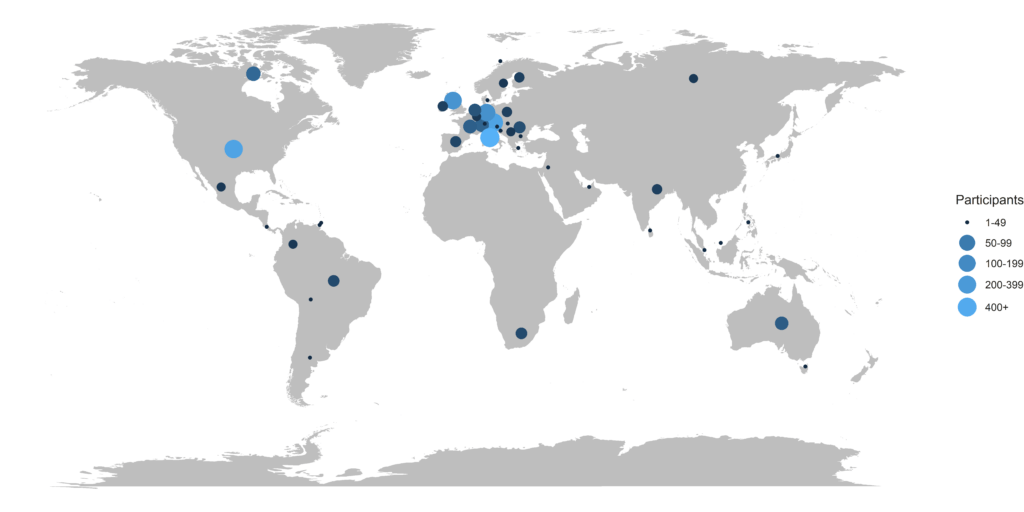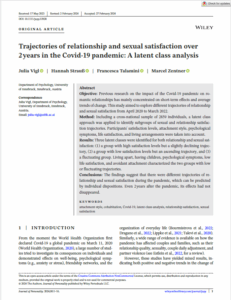About the Project
This project is a longitudinal study that was launched at the very beginning of the Covid-19 pandemic in April 2020 and ran for two years. Its aim is to take a closer look at romantic relationships during the pandemic, specifically to examine the trajectories of relationship and sexual satisfaction. Furthermore, we seek to identify factors that help or challenge couples under unusually stressful conditions, such as the current pandemic. We hope that this will facilitate the development and deployment of effective means of prevention and intervention for couples facing unusual challenges in the future.
Over 3000 individuals participated in the first measurement point of the study in April 2020 and shared the perceived changes in their relationships and living arrangements with us. More than 2500 individuals also took part in at least one of the five other measurement time points, which allowed us to draw conclusions about eventual changes in relationship dynamics during the pandemic.

Study design
The longitudinal study started in April 2020 and was open to all individuals who were currently in any form of romantic relationship. After participating in the first measurement point (T1), individuals were invited to the second and third measurement point individually after 10 days (T2 and T3). For the subsequent measurement time points, all participants were invited in November 2020 (T4), March 2021 (T5), and March 2022 (T6).

At each measurement point, participants were asked about their relationship and sexual satisfaction, about their worries regarding the pandemic, and about symptoms of stress, anxiety, and depression. At the first measurement time point, various life circumstances (living situation, occupation, demographic information) and stable personality traits (anxious and avoidant attachment style, negative affectivity) were assessed.
Publications and Findings
To date, we have published two articles on the project in peer-reviewed journals, and a third article is available as a preprint. In addition, we provide preliminary data, which have not yet been published as independent articles.
Published Articles, Preprints, and Additional Information
- Article 1
- Article 2
- Article 3
- Additional Information
- Media Coverage
Learn more about our first article, which was published in PLOS ONE as part as the Love in Times of Covid project.
In this article, we analyzed the first measurement point of our longitudinal study in April 2020 and addressed whether relationship and sexual satisfaction changed among cohabitating and non-cohabitating couples at the onset of the pandemic. In addition, we sought to identify vulnerabilities and resilience factors for romantic relationships.
 Learn more about the second article we published in the Journal of Personality as part of the Love in Times of Covid project.
Learn more about the second article we published in the Journal of Personality as part of the Love in Times of Covid project.
In this article, we focused on changes in relationship and sexual satisfaction among cohabitating and non-cohabitating couples, analyzing the study period of one year (April 2020 – March 2021). Moreover, we were able to show what influence external stressors, personal vulnerabilities as well as their interaction had on relationships during the pandemic.
 Learn more about the third article, wich was written as part of the Love in Times of Covid project and is currently available as a preprint.
Learn more about the third article, wich was written as part of the Love in Times of Covid project and is currently available as a preprint.
In this article, we extended the research period by another year (April 2020-March 2022) and were able to identify different classes of change patterns in relationship and sexual satisfaction during the pandemic. In addition to providing information on what proportion of the sample followed the different change trajectories during the pandemic, we were able to highlight predictors of class membership as well as predictors of breakups.
In this report, we provide insight into findings related to the project that are not addressed in the published articles. For example, you will find information about the changes in daily routine participants reported at the beginning of the pandemic, about the factors participants themselves experienced as predictors of an improvement or deterioration in their relationship, and about the extent to which domestic and care work developed during the pandemic.





Eine Antwort auf „Love in times of Covid“
thanks for info.